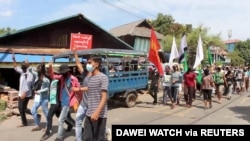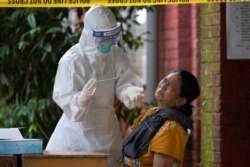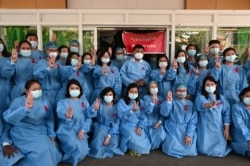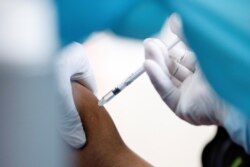Aid groups say Myanmar’s efforts to contain the novel coronavirus have been crumbling since a Feb. 1 coup that has plunged parts of the country into chaos, raising fears of a third wave of infections.
The military takeover has set off daily — and increasingly violent — confrontations with protesters across the country. A local rights group claims soldiers and police have rounded up thousands of people and killed more than 700, dozens of children among them, in a bid to quell resistance.
A so-called civil disobedience movement has also seen thousands of public and private sector workers go on strike, bringing much regular daily life and business to a grinding halt.
That includes the public health care system, threadbare even before the coup from decades of underfunding. Sources told VOA that thousands of doctors and nurses have walked off the job to join the strikes. Local news outlet Frontier Myanmar put the number of striking healthcare workers at over 60,000, citing a source at the Ministry of Health and Sports.
‘A perfect storm’
In an April 1 statement, the International Federation of Red Cross and Red Crescent Societies (IFRC) said the turmoil “poses a significant threat to efforts to contain the COVID-19 pandemic.”
“In the coming months we could be facing a perfect storm in Myanmar where another wave of COVID-19 infections collides with a deepening humanitarian crisis spreading across the entire country,” the statement quoted the federation’s Asia Pacific director, Alexander Matheou, as saying.
The U.N.’s acting resident country coordinator, Andrew Kirkwood, told reporters in a virtual press conference last month that Myanmar’s health system “has practically collapsed” and that “nearly all COVID-19 testing and treatment has halted.”
The head of the Health Ministry’s emerging infectious diseases unit, Khin Khin Gyi, rejected forecasts of an impending collapse while speaking with VOA last week. However, she confirmed that daily testing rates have plummeted, from as many as 25,000 a day before the coup to 2,000 at best now.
The number of confirmed new cases of COVID-19 has taken a similar dive.
The day before the coup, Myanmar had logged just over 140,000 total cases and 3,131 deaths. The country was on the downward slope of a second wave of infections, its worst since the pandemic began, but still registering hundreds of new cases a day.
Suddenly, from Feb. 5 to 6, confirmed new cases nosedived from 200 a day to zero, and they have averaged a few dozen a day since then.
Khin Khin Gyi conceded that the latest numbers reflect the drop in testing due to a lack of staff.
“We cannot test much, that’s why the case seems to be very much lower than the previous months,” she said.
“We can find only [the] tip of the iceberg, but we cannot find the submerged portion of the ice,” she added.
‘Paralyzed’
A source with an aid group in Myanmar’s health care sector told VOA that government hospitals and clinics have been hemorrhaging staff because of the strikes since the coup, reducing the facilities to skeleton crews or none, forcing some to close.
“We’ve seen that in several places,” he said, speaking on condition of anonymity for security reasons.
“The [civil disobedience movement] has paralyzed the public system, and of course as COVID-19 was a public [sector] response, it has paralyzed all the COVID systems,” he added.
The source said even the meager testing data available no longer comes out with key details including where positive cases were caught and whether the patients received treatment.
He shared the IFRC’s fears of a new wave of infections, just when the country was least prepared to handle it.
“Of course, we are concerned because… the junta cannot abolish COVID like it’s abolishing a lot of laws,” he said. “You can close your eyes, but the disease will keep on spreading.”
The country director of an international charity that had been cooperating with the ousted government on its pandemic response, also speaking anonymously, said Myanmar’s modest private health care system had taken on some of the burden from the public sector but was no substitute.
“Many of the public hospitals have basically been shut down or taken over by the military,” he told VOA. “So, what you’ve got is just this kind of menagerie of private clinics or newly cropped-up health facilities to try and deal with [patients], whether it’s shootings from the coup or others who may have other issues.”
He said the unrest and understaffing made contact tracing all but unthinkable and “close to impossible to roll out any coordinated, organized vaccination campaign.”
Fear and loathing
Myanmar administered its first shot of a COVID-19 vaccine, to a nurse at Yangon General Hospital, on Jan. 27, a few days before the coup.
The Health Ministry’s Khin Khin Gyi said public hospitals have given out some 1.4 million shots since, mostly to government staff, and that daily numbers were on the rise as some of the staff who joined the strikes trickle back to work.
Before the coup, the government had set itself the goal of vaccinating 40% of its 54 million people by the end of 2021. Khin Khin Gyi said the target was “tentative” and had no idea if the new regime would meet it.
Fear and boycotts stand in the way.
Frontier Myanmar reported that most of the health care staff on strike are refusing to get their second shots until the junta retreats, and out of concern that they will be forced back to work if they show up for the vaccine.
The charity country director said rampant reports of arbitrary arrests and random shootings by police and soldiers on patrol have most of his own staff simply too afraid to leave their homes, whether for a handout of rice or a free vaccination.
And with a widely reviled military turning back the clock on years of hard-earned progress toward democracy, he added, the risk of catching COVID-19 now seems, to most, the far lesser of two evils.
“People, honestly, they’re really not concerned about another outbreak,” he said. “They’re more concerned about trying to get this junta out of power. The likelihood that there’s an outbreak going on right now is probably pretty high, it’s just going to be close to impossible to get any kind of accurate figures.”













